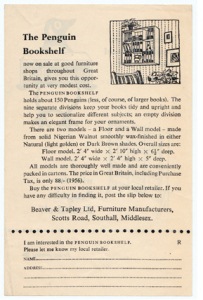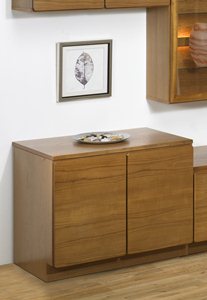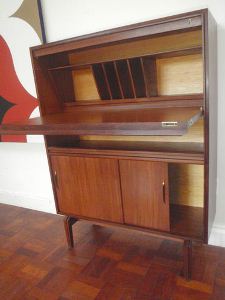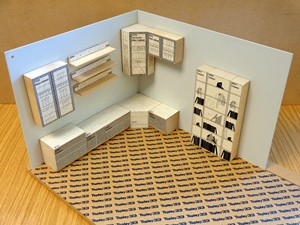Heritage
The firm was founded in London by Newman Richardson, shortly before the end of the first World War, to deal in Government surplus.
Surprisingly, there was never a Mr Beaver or a Mr Tapley. The name was created by Newman Richardson to sound as if the Company was old and established. This led to the sale of regimental ties and from that to screw-up tie presses and trouser presses which were a great success.
In the early thirties the company started manufacturing tea trolleys, utilising the same raw materials, which is how Beaver and Tapley became furniture manufacturers. The company made and sold an increasing range of occasional and some bedroom furniture, with a break during the Second World War, selling the product ranges wholly on price.
In 1956 Roger joined his father Justin Richardson in the business and together they decided that just being cheaper than their competitors was not the way forwards in the long term. They decided on a number of new strategies; to use some top designers; to advertise nationally; to sell on quality and design and not purely on price.
The first venture was the Penguin Bookshelf, designed in collaboration with Penguin Books. This was sold under an adaption of their trademark, and advertised within inserts in Penguins.


Shown: Taken from a 1956 publication.
It was an overwhelming trade success, with orders from almost every furniture retailer in the country. However, with hindsight, calling it the Penguin Bookshelf was a mistake as people thought it was only for Penguin Books. The design, shelves and uprights in a square frame, was right as a wall hanging version but not for the floor standing model.
Shown: c1950’s example of the Penguin Bookshelf in Walnut
However, the company was convinced about the wall hanging idea. Saving space in the smaller rooms of new houses – only one floor but four walls in every room – and was determined to succeed.
Shown: c1960’s Robert Heritage Bookcase for Beaver and Tapley in Teak

The way forwards became clear when, in 1960, Roger Richardson and the designer Robert Heritage, visited the Cologne Exhibition. Here they saw a Swedish range of cabinets and shelves systems supported by wall fixed wire ladders. They decided to do away with the constricting ladders, providing a concealed fixing batten for each piece, making space saving furniture with complete freedom of arrangement. The first wall fixed range Tapley SL (SL for spirit level because there was one in every batten) was launched in 1961.
Shown: c1970s Tapley SL Wall Hung Drawer Unit in Teak
Tapley SL was withdrawn in 1978, when it was overtaken by it successor, Tapley 33, which was first sold in 1975. The first cabinets were all thirty three inches wide.

Shown: 33” Base Cupboard Unit in Teak
The reason for the change was the need to provide an adjustable fixing device. Multiple piece arrangements of Tapley SL had shown that no walls are truly flat and a mechanical means of lining up was essential. This led to the development of the metal wall bar, which came with every wall fixed piece of Tapley 33. Floor standing pieces were soon added and the range took shape as its popularity increased.
Shown: Tapley 33 Model Home Design Kit
In the early eighties Burgundy Oak was introduced as an alternative to teak and the sale of separate tops and base units came out which gave the floor models as much flexibility as their wall hung counterparts.
In the early nineties Light Oak became the third finish option with Cherry being introduced as a fourth finish in the late nineties.
The modular furniture range of Tapley 33 had giving consumers the opportunity to move away from the traditional individual pieces of furniture. Consumers were now able to design their own room sets and layouts with as many or as few pieces as they wished. Three generations of the Richardson family, created and firmly established the Beaver and Tapley Brand, with furniture designed and manufactured entirely in the UK.
In 1998 the Richardson family made the decision to sell the business to three private investors. Sadly these new investors were to bring many unwelcome changes from both the company’s and the customer’s point of view. In particular the move of premises from the original site in Southall, Middlesex, to Nottingham. The product range was reduced and the name changed to Tapley Elements along with the introduction of the Tapley Spirit range. The many changes brought a difficult time in Beaver and Tapley’s history and ultimately resulted in the sale of the business in 2005 to its current owners.
The range has since been restored to its original name Tapley 33 and the number of items increased to nearly 150 pieces. In late 2007 the mono range of Black and white was introduced. 2012 brings us the Warm Oak finish. It has been with proud determination and enthusiasm that the Tapley 33 brand has been re-established and carefully expanded.
We are very privileged to have the opportunity to own such a well known brand, which has been established through design innovation, quality and the pursuit of its excellence.
It is our intention to continue that development with the introduction of new and interesting furniture pieces, always contemporary, always high quality, always to tempt you.
Last year saw the opening of our factory showroom based in Andover, Hampshire. This is where we are showcasing our full range of furniture in all of our finishes Teak, Light Oak, Warm Oak, Black and White along with our new additions of Amercian Walnut, Stone and Canvas. Throughout last year we worked very closely with the market leading trade journal The Cabinet Maker, actively promoting the brand through articles and advertising.
2018 brings new challenges and we will be looking at further developing the factory showroom, along with a new brochure offering.
We would like to take this opportunity to thank our customers and we look forward to seeing you at Andover very soon!





